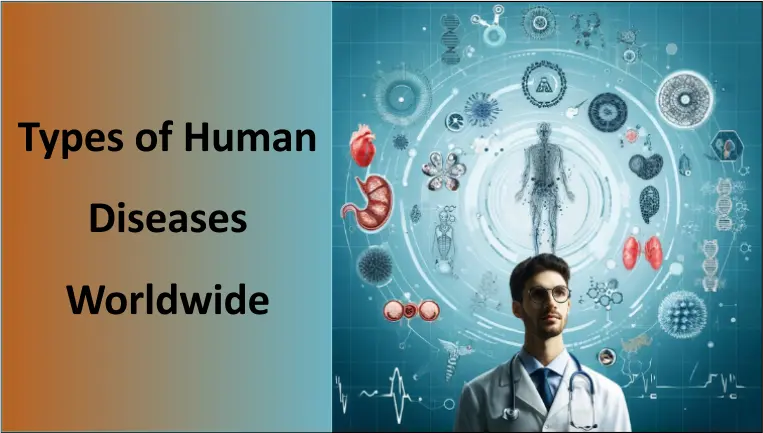Types of Human Diseases Worldwide | SR
Human Diseases
In modern medical science Human diseases are not just random occurrences. They are meticulously classified based on their causes, the body parts they affect, and the mechanisms they employ. This classification system is a matter of interest and a shared responsibility. This guide will demystify the different types of human diseases, providing clear and detailed explanations for each category. In the Tibb-e-Unani medicine system, all these diseases come under temperament. In future articles, we will delve into their treatment through Tibb-e-Unani, arming you with the knowledge to make informed decisions about your health.
Infectious Diseases
Definition: Infectious diseases, a significant threat to our health, are caused by pathogenic microorganisms like bacteria, viruses, fungi, and parasites. These Human diseases can spread from one person to another directly or indirectly, underscoring the importance of prevention and early detection.
Types and Examples:
1. Bacterial Infections:
Tuberculosis (TB): Caused by Mycobacterium tuberculosis,
Tuberculosis affects the lungs but can spread to other organs.
– Strep Throat: Caused by Streptococcus bacteria, it leads to sore throat and fever.
Urinary Tract Infections (UTIs): These infections affect the bladder and urethra and are often caused by Escherichia coli.
2. Viral Infections:
Influenza (Flu): Influenza viruses cause fever, cough, and body aches.
– HIV/AIDS: Human Immunodeficiency Virus (HIV) attacks the immune system, leading to Acquired Immunodeficiency Syndrome (AIDS).
– COVID-19: Caused by the novel coronavirus SARS-CoV-2, it affects the respiratory system and can lead to severe complications.
3. Fungal Infections:
– Candidiasis: Caused by Candida species, it can affect the mouth, throat, and genital areas.
– Aspergillosis: Caused by Aspergillus fungi, it affects the lungs and other organs.
4. Parasitic Infections:
– Malaria: Caused by Plasmodium parasites, transmitted by Anopheles mosquitoes.
– Giardiasis: Caused by Giardia lamblia, it affects the intestines and causes diarrhea.
Genetic and Congenital Diseases
Definition: Genetic Human diseases are caused by abnormalities in an individual’s DNA, while congenital diseases are conditions present from birth that may be due to genetic or environmental factors.
Types and Examples:
1. Single-Gene Disorders:
– Cystic Fibrosis: Caused by mutations in the CFTR gene, it affects the respiratory and digestive systems.
– Sickle Cell Anemia: Caused by a mutation in the HBB gene leads to abnormally shaped red blood cells.
2. Chromosomal Disorders:
– Down Syndrome: Caused by an extra copy of chromosome 21, it leads to developmental delays and intellectual disabilities.
– Turner Syndrome: Caused by the complete or partial absence of one X chromosome in females.
3. Multifactorial Disorders:
– Heart Disease: Results from genetic and environmental factors.
– Type 2 Diabetes: Involves multiple genes and lifestyle factors.
4. Congenital Malformations:
– Cleft Lip and Palate: A congenital disability affecting the upper lip and the roof of the mouth.
– Spina Bifida: A neural tube defect that affects the spine.
Autoimmune Diseases
**Definition**: Autoimmune diseases occur when the immune system mistakenly attacks the body’s cells and tissues.
Types and Examples:
1. Systemic Lupus Erythematosus (SLE): Affects various organs, including the skin, joints, kidneys, and brain.
2. Rheumatoid Arthritis: Causes inflammation of the joints, leading to pain and swelling.
3. Type 1 Diabetes: The immune system attacks insulin-producing cells in the pancreas.
4. Multiple Sclerosis (MS): The immune system attacks the protective covering of nerves, leading to neurological symptoms.
Metabolic Disorders
Definition: Metabolic disorders result from abnormal chemical reactions in the body’s metabolism.
Types and Examples:
1. Diabetes Mellitus:
– Type 1 Diabetes: The body does not produce insulin.
– Type 2 Diabetes: The body becomes resistant to insulin.
2. Hyperthyroidism: The thyroid gland produces excessive hormones.
3. Hypothyroidism: The thyroid gland produces insufficient hormones.
4. Phenylketonuria (PKU): The body cannot break down the amino acid phenylalanine.
Nutritional Deficiency Diseases
Definition: Nutritional deficiency diseases occur due to inadequate intake or absorption of essential nutrients.
Types and Examples:
1. Scurvy: Caused by a vitamin C deficiency, leading to bleeding gums and joint pain.
2. Rickets: Caused by a vitamin D deficiency, weakening children’s bones.
3. Anemia: Often caused by iron deficiency, leading to fatigue and weakness.
4. Pellagra: Caused by a deficiency of niacin (vitamin B3), leading to diarrhea, dermatitis, and dementia.
Chronic Diseases
**Definition**: Chronic Human diseases are long-lasting conditions that often progress slowly and can be controlled but not cured.
Types and Examples:
1. Cardiovascular Diseases:
– Hypertension: Chronic high blood pressure.
– Coronary Artery Disease: Caused by plaque buildup in the arteries.
2. Respiratory Diseases:
– Chronic Obstructive Pulmonary Disease (COPD): Includes chronic bronchitis and emphysema.
– Asthma: A condition in which airways narrow and swell, causing difficulty in breathing.
3. Cancer:
– Lung Cancer: Often caused by smoking, it affects the lungs.
– Breast Cancer: Affects the breast tissues and can spread to other parts of the body.
4. Kidney Diseases:
– Chronic Kidney Disease (CKD): Gradual loss of kidney function over time.
– Kidney Stones: Hard deposits of minerals and salts that form in the kidneys.
Mental Health Disorders
Definition: Mental health disorders affect an individual’s mood, thinking, and behavior.
Types and Examples:
1. Mood Disorders:
– Depression: Persistent sadness and loss of interest in activities.
– Bipolar Disorder: Characterized by extreme mood swings.
2. Anxiety Disorders:
– Generalized Anxiety Disorder (GAD): Excessive, uncontrollable worry about various aspects of life.
– Panic Disorder: Recurrent panic attacks and fear of future attacks.
3. Psychotic Disorders:
– Schizophrenia: Involves distorted thinking and perceptions.
4. Eating Disorders:
– Anorexia Nervosa: An intense fear of gaining weight leading to severe food restriction.
– Bulimia Nervosa: Cycles of binge eating followed by purging.
Neurological Disorders
Definition: Neurological disorders affect the nervous system, including the brain, spinal cord, and nerves.
Types and Examples:
1. Alzheimer’s Disease: Progressive neurodegenerative disease leading to memory loss and cognitive decline.
2. Parkinson’s Disease: Affects movement, causing tremors and stiffness.
3. Epilepsy: A disorder characterized by recurrent seizures.
4. Migraine: Severe headaches often accompanied by nausea and sensitivity to light.
Musculoskeletal Disorders
Definition: Musculoskeletal disorders affect the bones, muscles, joints, and connective tissues.
Types and Examples:
1. Osteoarthritis: Degenerative joint disease causing pain and stiffness.
2. Rheumatoid Arthritis: An autoimmune disorder affecting the joints.
3. Osteoporosis: Weakening of bones, making them more prone to fractures.
4. Fibromyalgia: Chronic widespread muscle pain and tenderness.
Gastrointestinal Diseases
Definition: Gastrointestinal diseases affect the digestive tract, including the stomach, intestines, and related organs.
Types and Examples:
1. Gastroesophageal Reflux Disease (GERD): Acid reflux causing heartburn and discomfort.
2. Irritable Bowel Syndrome (IBS): Causes abdominal pain and changes in bowel habits.
3. Crohn’s Disease: Inflammatory bowel disease affecting any part of the gastrointestinal tract.
4. Ulcerative Colitis: Chronic inflammation of the colon.
Dermatological Diseases
Definition: Dermatological Human diseases affect the skin, hair, and nails.
Types and Examples:
1. Eczema: Causes itchy, inflamed skin.
2. Psoriasis: Chronic skin condition characterized by red, scaly patches.
3. Acne: A common skin condition causing pimples and cysts.
4. Rosacea: Causes redness and visible blood vessels in the face.
Conclusion
Understanding the various types of human diseases in modern medical science is crucial for effective diagnosis, treatment, and prevention. Every kind of disease has unique characteristics and requires specific approaches to manage. In future articles, we will explore the treatment of these diseases using Tibb-e-Unani/Eastern Medicine, a traditional system of medicine that focuses on natural healing and balance.
We aim to keep our readers engaged and informed about human health and disease by providing comprehensive, easy-to-understand information.




